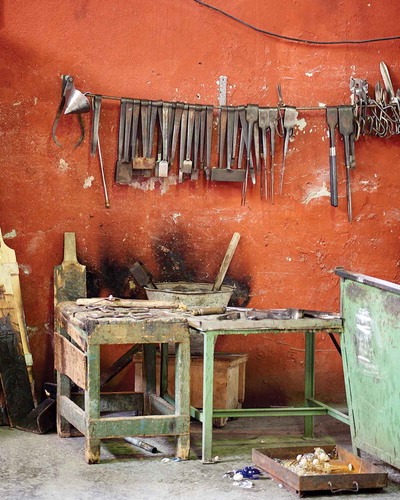In their self-presentation and identity, the glass furnaces on Murano today are inseparable from a medieval past – to be precise, from 1291 when the Republic of Venice forced glass makers to leave the city and confined them to Murano. That identity is conveyed in the evidently long-preserved character of the workshop and the movements of artisans working there in 2018; it is an identity built around a core set of craft technologies embodied in traditional techniques and tools and delimited by particular spaces. In this photo we see a range of metal and wooden hand tools that craftsmen use to transform molten glass into delicate shapes. The scorched wall and glass debris signal the presence of the furnace just a few feet away. These tools and their use in this space simultaneously reflect a persistent set of practices and constitute an ongoing celebration of heritage. In open defiance of modernizing trends in other places of manufacture, these processes and implements are still to be found around the glass furnaces on Murano, many centuries after their historic relegation. They are not to be found elsewhere, the operating workshop suggests, nor should they be sought. Nor are they merely archaic or quaint, but instead they invest the products of these spaces and practices with values: inter alia, scarcity, uniqueness, master craftsmanship, labor, tradition, and fidelity to heritage. Visitors are invited to observe craftsmen working in this space. Through a kind of voyeurism, then, visitors come to see the glass objects in the nearby showrooms, galleries, and boutique shops as the embodiment of those values and therefore worth their high prices.
Photographs of the glassworkers’ bench not only disseminate further the values of the glass objects and justify the tourists’ spending, but such photographs also attract the historian’s attention and invite interrogation and reflection. The historian’s analysis must, however, be tempered by an understanding that the photograph does not merely capture a set of practices and therefore values but reflects various choices the touring photographer made. The photographer’s decisions, for example, to exclude the garish plastic clock hanging on the wall just out of the frame, and to wait until the craftsman who was talking on his cellphone stepped away from the bench, produced a particular image that carefully and intentionally selected only a portion of the encounter between photographer and place.
Indicators of the photographer’s skill, or the absence of such indicators, also influence how historians view the image. The focused, correctly exposed, and level image elicits a different analysis from that called forth by an out-of-focus, over-exposed, off-kilter snapshot. Likewise, the implied scarcity or uniqueness of the photograph encourages the historian to consider it a product of intentional labor in a way that distinguishes it from similar images posted innumerable times to assorted social media websites. Whereas tourists have been invited into the workshops on Murano to witness the fabrication of the fine glass objects for sale in the galleries, historians are rarely invited to see the production of the photograph, to watch the watcher. Nevertheless, the photograph that holds our eyes and gains our appreciation, no less than the glass objet d’art, embodies a set of practices and choices that shape how the historian views it and must therefore inform the historian’s analysis.

